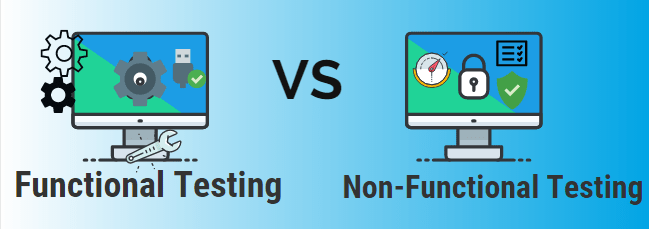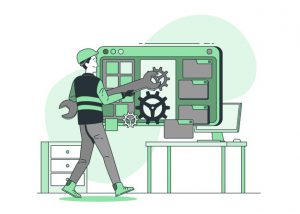Every software development life cycle includes testing as one of the essential steps to creating a great product. Various aspects of the software system are checked using different tests that can be divided into functional and non-functional testing.
In this post, we are going to talk about what makes the types of testing different from each other. We will discuss functional and non-functional software testing types that you can use to secure your project’s quality.
What is functional testing?
Functional testing verifies that the operational execution of a program or mobile app happens according to the technical and business requirements. Only if every feature of a software system works correctly, it can pass a functional test.
Functional testing is usually conducted before non-functional testing and is done manually. The tester provides specific inputs to the program and compares the result with the expected output. Functional testers are not concerned about the source code but focus on checking the functionality.
In layman terms, when you conduct functional testing you are interested in what the system can do. It is necessary to do this type of testing to ensure that the product does not have bugs or vulnerabilities.
What is non-functional testing?
Non-functional testing checks all the aspects not covered in functional tests. It includes the performance, usability, scalability, and reliability of the software.
We conduct non-functional testing to make sure that the interests of the end-user are respected. The product will not enjoy success unless you manage to meet customer expectations. Non-functional testing is essential to add market value to the product.
This type of testing demands much more creativity from a tester. It has nothing in common with the mechanical work of clicking the right buttons. The testing specialist has to develop a strategy to collect customer expectations and offer a set of tests to check how these expectations are met.
The results of non-functional testing are measured on the scale. If functional testing specifies what the program should do, non-functional tests describe how it should behave. For example, how intuitive the interface is or how well the system operates under high load.
Non-functional testing is often automated. Specialized tools help to model a real-life environment and see how the software is going to behave under pre-set conditions. Non-functional tests also rely on customer feedback and focus groups, especially in what concerns usability testing.
Difference between functional and non-functional testing
The easiest way to understand the domains of functional and non-functional testing is to have a look at some questions they help to answer.
Functional testing questions
- Is a confirmation email sent after the user registers on a website?
- Does the feedback notification appear if the user uploads a larger file than the system asks it?
- When the user clicks on an icon that is supposed to be clickable, does the new page load?
Non-functional testing questions
- How much time does it take for the user to receive a registration confirmation email?
- Does the feedback notification comply with the principles of user-friendly push notifications design?
- Is it transparent for the user where to click to load a new page?
Functional testing questions can often be answered with a simple yes or no. Non-functional testing gives gradable answers.
| Functional Testing | Non-Functional Testing |
| Tests features/functions | Tests non-functional aspects |
| Evaluated as either present or not present | Evaluated on the scale |
| Usually done manually | Usually automated |
| Checks the accordance to customer requirements | Checks the accordance to end-user expectations |
| Tests what the product does | Tests how the product works |
| Requirements are easy to specify | Requirements are hard to specify |
Which type of testing is better? The answer is none. They cannot be used interchangeably. Functional and non-functional testing cover different aspects of software systems and should be both used for quality assurance.
Functional testing types
There are different functional testing strategies that you can use for your benefit. The best way to ensure functional coverage is to use both manual and automation testing methods.
- Smoke testing. Before the actual testing, smoke testing is conducted to see that the main functionalities are working fine before fine-tuning other testing procedures.
- Sanity testing. After a bug was fixed or functionality added, you need to understand that there are no issues that appeared due to this change.
- Unit testing. Unit tests are done to check individual units or components of the system.
- Integration testing. To test whether multiple software components function well together as a group, you will need integration testing.
- Boundary value testing. When the software system sets limits on the input data, you need to check that this functionality is working correctly. Example: a password field that should include at least eight characters, one number, one uppercase letter, one lowercase letter, and one special symbol.
- API testing. Integrating third-party services is always a potential source of bugs and memory leakages. If your project uses APIs, you should test that they are working correctly.
- User acceptance. It validates that the functionality, accessibility, and quality are high enough for the application to be used in real-life.
- Regression testing. This one is done to verify that the recent changes or updates have no negative effect on the already existing functionality.
- Globalization testing. Organizations today strive to design products that can perform successfully in international markets. This type of testing validates that the product will be accessible to users from foreign countries.
- Interoperability testing. It confirms that the software can interact with other software systems and components without any compatibility issues.
- Interface testing. To check whether the users will interact with the interface as expected, you need interface testing. To conduct it, you gather an end-user group that will perform specific tasks. It helps identify the elements of the software that the user often uses and whether these elements behave according to the requirements. It is essential not to confuse interface testing with usability testing. User interface testing checks that the interface works fine and passes the data to the system. Usability testing is done to see whether end-users will find the application convenient and useful.
Non-functional testing types
Now we are going to look at the non-functional testing types.
- Availability testing. You need to test how often the product is going to be used and whether it is accessible when the users need it. For example, you want to minimize failure events or predict how much time the repair can take before the system goes back to normal.
- Performance testing. The tester executes this type of testing to verify that the website or application performs well under the expected workload.
- Compatibility testing. This type of testing validates how seamlessly the product operates with other components: OS, browsers, hardware, and so on.
- Localization testing. Localization testing checks that the product meets the expectations of a local audience. For example, if you localize a mobile app designed for the USA to the Chinese market and translate it in Chinese, you will have to use this type of testing.
- Volume testing. This type of testing analyzes how well the system operates under the ever-growing volume of processed data.
- Scalability testing. The software testing procedure that ensures that the product can grow in proportion to the increasing demands of the end-users is called scalability testing.
- Usability testing. Use it to validate how human-friendly your application is.
- Reliability testing. This software testing strategy combines stress, security, and functionality testing, and describes whether the software product meets the standards of functionality.
- Security testing. The tester tries to find the system’s vulnerabilities and determine how well the confidential data and internal resources are protected.
- Load testing. To know how the software will behave under a particular load is vital if you want to guarantee the interoperable performance to the users. Load testing helps you to check the quality of your system under high peak loads.
- Endurance testing. This type of testing is used to estimate the efficiency of a program under high loads. However, the load is continuously increasing and lasts for a long time.
- Compliance testing. This type of software testing verifies that the product meets international standards of software development, usually developed by global companies. For instance, it is important for a mobile application to be compliant to the App Store or Google Play regulations.
- Stress testing. Conduct this type of testing to see how the program behaves under varying load and stress to the app’s functionality.
- Maintainability testing. The ability of a program to safely go through changes and updates is crucial. Maintainability testing measures how well the system copes with changes.
- Portability testing. It determines how easy it is to transport a software component or application from one hardware or OS to another.
- Disaster recovery testing. This type of testing is applied to estimate how much time it takes to recover and how well the software manages to recover data after crashes or network blackouts.
| Functional Testing Strategies | Non-functional Testing Strategies |
|---|---|
| Unit testing | Availability testing |
| Integration testing | Performance testing |
| Boundary value testing | Compatibility testing |
| API testing | Localization testing |
| User Acceptance | Volume testing |
| Regression testing | Scalability testing |
| Globalization testing | Usability testing |
| Interoperability testing | Reliability testing |
| Interface testing | Security testing |
| Smoke testing | Load testing |
| Sanity testing | Endurance testing |
| System testing | Compliance testing |
| Installation testing | |
| Stress testing | |
| Maintainability testing | |
| Portability testing | |
| Disaster recovery testing |
Summing up
Applying both functional and non-functional testing techniques, you verify your software product’s functionality and make sure that it corresponds with the highest standards of quality. Do not trust your digital product’s success to the wheel of fortune – address a professional QA agency that has experience in different types of testing. They will advise you on the best strategies and make sure that your app’s quality is outstanding.










Which one is easy to work? Functional or non functional?
Functional testing will be always easy to work.